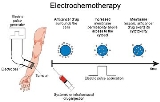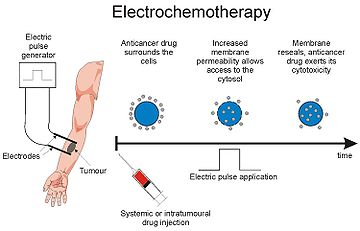
Electrochemotherapy
Encyclopedia
Electrochemotherapy is a therapeutic approach providing delivery into cell interior of non-permeant drugs with intracellular targets. It is based on the local application of short and intense electric pulses that transiently permeabilize cell membrane, thus allowing transport of molecules otherwise not permitted by a cellular membrane [1,2]. Applications for treatment of cutaneous and subcutaneous tumors have reached clinical use (antitumor electrochemotherapy using bleomycin or cisplatin) [3-12]. Electrochemotherapy with bleomycin has been used to treat the patient for the first time in 1991 at the Institute Gustave Roussy in France [13], while electrochemotherapy with cisplatin has been used to treat the patient for the first time in 1995 at the Institute of Oncology, Ljubljana, Slovenia [14]. Since then more than 4000 patients were treated with electrochemotherapy all over the world (Australia, Austria, Belgium, Bulgaria, Denmark, France, Germany, Greece, Hungary, Ireland, Italy, Japan, Mexico, Nicaragua, Poland, Portugal, Slovenia, Spain, Sweden, UK, USA). Recently, new electrochemotherapy modalities have been developed for treatment of internal tumors using surgical procedures, endoscopic routes or percutaneous approaches to gain access to the treatment area [15,16].
 When a biological cell is exposed to an electric field of sufficient strength, an increase in the trans-membrane voltage is generated, which leads to structural rearrangements of the cell membrane structure [17-22]. These changes result in an increase of the cell membrane permeability, which allows nonpermeant molecules to enter the cell [13,23,24]. This phenomenon is called electroporation (or electropermeabilization) and is becoming widely used to improve anticancer drug delivery into cells, which is being referred to as electrochemotherapy.
When a biological cell is exposed to an electric field of sufficient strength, an increase in the trans-membrane voltage is generated, which leads to structural rearrangements of the cell membrane structure [17-22]. These changes result in an increase of the cell membrane permeability, which allows nonpermeant molecules to enter the cell [13,23,24]. This phenomenon is called electroporation (or electropermeabilization) and is becoming widely used to improve anticancer drug delivery into cells, which is being referred to as electrochemotherapy.
All biomedical applications of cell electropermeabilization use monopolar DC short and intense pulses (even though in vitro, in bacteria, time-decayed pulses can be used). Amplitude of the pulses depends on the tissues and on the shape and position of the electrodes, but, in vivo, in the case of the tumors, the amplitude of the electric pulses has to be high enough to establish an electrical field of 400 V/cm in the area of tumor (8 pulses with duration of 100 microseconds) [25]. The length of pulses is usually one hundred microseconds. In early experiments, pulses were delivered with period of 1 second (i.e. at a repetition frequency of 1 Hz), nowadays however pulses are delivered in a much shorter time period, at a repetition frequency of 5000 Hz, resulting in a much less discomfort for the patient and in the shorter duration of treatment [26,27]. For treatment of deep seated tumors in relative vicinity of the heart, pulses are synchronized with absolute refractory period of the heart of each heartbeat to minimize the probability of interaction of pulses with the heart function [28, http://www.clinicaltrials.gov/ct2/show/NCT01264952]. Pulses are being delivered in a series of eight pulses, but can be repeated if necessary.
 The electrochemotherapeutic treatment consists of delivering, either systemically or locally, non-permeant cytotoxic drugs (e.g. bleomycin) or low-permeant drugs (i.e. cisplatin) and applying electric pulses to the area to be treated when the concentration of the drug in the tumour is at its peak [12]. With the delivery of the electric pulses, cells are subjected to the electric field that causes the formation of nanoscale defects on the cell membrane which alter the permeability of the membrane. At this stage and for some time after pulses are delivered, molecules of the cytotoxic agents can freely diffuse into the cytoplasm and exert their cytotoxic effect. Multiple positioning of the electrodes, and subsequent pulse delivery, can be performed during a session to be able to treat the whole lesion, provided that drug concentration is sufficient [25]. Treatment can be repeated over the course of weeks or months to achieve regression of large lesions.
The electrochemotherapeutic treatment consists of delivering, either systemically or locally, non-permeant cytotoxic drugs (e.g. bleomycin) or low-permeant drugs (i.e. cisplatin) and applying electric pulses to the area to be treated when the concentration of the drug in the tumour is at its peak [12]. With the delivery of the electric pulses, cells are subjected to the electric field that causes the formation of nanoscale defects on the cell membrane which alter the permeability of the membrane. At this stage and for some time after pulses are delivered, molecules of the cytotoxic agents can freely diffuse into the cytoplasm and exert their cytotoxic effect. Multiple positioning of the electrodes, and subsequent pulse delivery, can be performed during a session to be able to treat the whole lesion, provided that drug concentration is sufficient [25]. Treatment can be repeated over the course of weeks or months to achieve regression of large lesions.
 The electrochemotherapy has already been approved and reimbursed in several EU countries (Denmark, Germany, Greece, Italy, Poland, Portugal, Slovenia, UK). The CE-marked device Cliniporator TM (Igea s.r.l., Carpy, Italy) has been certified as the medical device and is offered on the market along with Standard Operating Procedures for electrochemotherapy of cutaneous and subcutaneous tumors [4,34].
The electrochemotherapy has already been approved and reimbursed in several EU countries (Denmark, Germany, Greece, Italy, Poland, Portugal, Slovenia, UK). The CE-marked device Cliniporator TM (Igea s.r.l., Carpy, Italy) has been certified as the medical device and is offered on the market along with Standard Operating Procedures for electrochemotherapy of cutaneous and subcutaneous tumors [4,34].
Physical principle

All biomedical applications of cell electropermeabilization use monopolar DC short and intense pulses (even though in vitro, in bacteria, time-decayed pulses can be used). Amplitude of the pulses depends on the tissues and on the shape and position of the electrodes, but, in vivo, in the case of the tumors, the amplitude of the electric pulses has to be high enough to establish an electrical field of 400 V/cm in the area of tumor (8 pulses with duration of 100 microseconds) [25]. The length of pulses is usually one hundred microseconds. In early experiments, pulses were delivered with period of 1 second (i.e. at a repetition frequency of 1 Hz), nowadays however pulses are delivered in a much shorter time period, at a repetition frequency of 5000 Hz, resulting in a much less discomfort for the patient and in the shorter duration of treatment [26,27]. For treatment of deep seated tumors in relative vicinity of the heart, pulses are synchronized with absolute refractory period of the heart of each heartbeat to minimize the probability of interaction of pulses with the heart function [28, http://www.clinicaltrials.gov/ct2/show/NCT01264952]. Pulses are being delivered in a series of eight pulses, but can be repeated if necessary.
Description of the treatment

Efficacy, clinical relevance
In a number of clinical studies (phase II and phase III) investigators have concluded that electrochemotherapy of cutaneous or subcutaneous metastasis or tumours with bleomycin and cisplatin have an objective response rate of more than 80% [29]. Reduction of tumor size has been achieved with electrochemotherapy faster and more efficiently than in standard chemotherapy for both cutaneous and subcutaneous tumors. Patients with skin metastasis from melanoma, Kaposi sarcoma, squamous cell carcinoma, basal cell carcinoma, adenocarcinoma or breast cancer have been successfully treated [4-7,9,10,30]. First clinical results of electrochemotherapy of internal tumors (e.g. liver metastases) are also promising and encouraging.Safety
Electrochemotherapy employs lower dosages of chemotherapeutic drugs than standard chemotherapy protocols, thus the patient’s burden usually associated to chemotherapy is not present. In the clinical use of electrochemotherapy limited side effects related to bleomycin or cisplatin use are recorded. Provided that appropriate anaesthesia is used for alleviation of the symptoms associated with application of electric pulses, the control of the pain level during the electrochemotherapy is good and acceptable for the patients. Beside pain which is limited to the treated tumour and surrounding tissue, muscle contraction during electric pulse delivery is the only discomfort for the patients associated with electrochemotherapy [4]. There is also induction of a vascular lock by the type of pulses used in electrochemotherapy: for a few minutes blood flow is interrupted in the treated volume in the normal tissues [31,32]. Its duration is too short to induce deleterious effects due to ischemia. In tumors however, vascular lock is of a longer duration and can contribute to the effectiveness of the electrochemotherapy. A good indicator that electrochemotherapy is not a stressful or painful procedure is that the majority of the patients interviewed during a clinical study aimed at defining the European Standard Operating Procedure of Electrochemotherapy (ESOPE) would be willing to accept the treatment another time if it would be necessary [4].Veterinary use
Electrochemotherapy is also used in veterinary oncology in dogs, cats and horses. There are centres in Brazil, France, Italy, Ireland, Slovenia and UK where this treatment is available. It is used for a wide variety of tumours [33].Remarks


